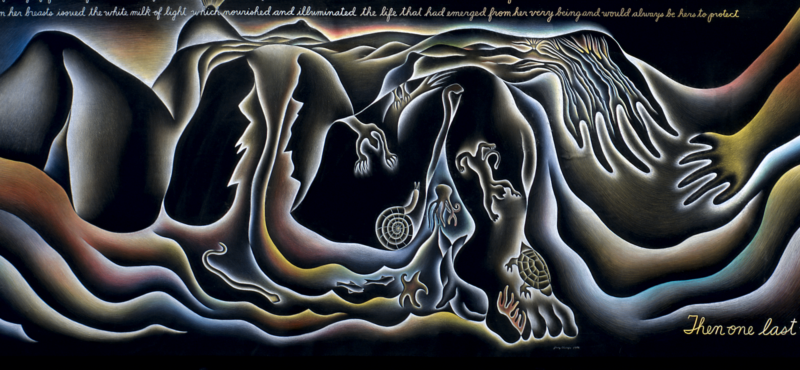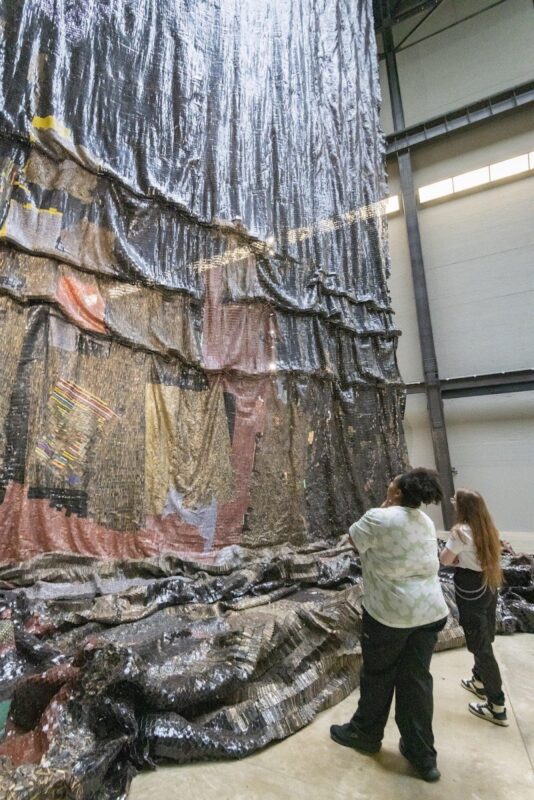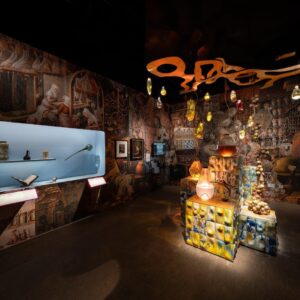This Autumn, Serpentine Arts Technologies and artist Gabriel Massan announce a collaboration leveraging the open-source blockchain Tezos on a new world-building game project. Serpentine Arts Technologies will also release the third edition of the annual strategic briefing Future Art Ecosystems uncovering new implications of emerging Web3 technologies for the construction of public cultural infrastructure
The Serpentine Arts Technologies programme proposes critical and interdisciplinary perspectives on advanced technologies through artistic interventions, challenging and reshaping the role that technologies can play in culture and society. Produced by Serpentine Arts Technologies, Future Art Ecosystems (FAE) is an annual strategic briefing launched in 2020 that provides concepts, references, language, and arguments that can be integrated into operational agendas for the construction of 21st century cultural infrastructure: the systems required to produce, distribute, and financially support experimental artistic engagements with emerging and advanced technologies.

ARTIST WORLDS 2023: THIRD WORLD: THE BOTTOM DIMENSION
Launching February 2023
Serpentine is delighted to have selected Tezos, the energy-efficient blockchain for Artist Worlds 2023, an experimental commission series that utilises virtual world-building to provide insight into an artist’s practice and expanded worldview.
Following the inaugural Artist Worlds commission, Primal Tourism, produced in 2021 by Jakob Kudsk Steensen, Serpentine will unveil a multilevel downloadable game and a complementary blockchain-based project developed with Brazilian artist Gabriel Massan and a team of collaborators. Third World, is described by Massan as a ‘consciousness-raising game that explores Black-Indigenous Brazilian experiences.’ Itwill launch in February 2023 online via Steam and onsite at Serpentine and amplify Serpentine’s commitment to gaming projects.
This year’s inaugural Artist Worlds commission is a groundbreaking collaboration for Serpentine. Artist Worlds will bring an incredible digital artist, Gabriel Massan, to the growing artist community and feature elements on the Tezos blockchain. Serpentine is proud to publish our Arts Technologies team’s third Future Art Ecosystems report, Building Hybrid Worlds, exploring the intersection of art. Projects like Massan’s Third World video game are powerful vehicles that allow audiences around the world to explore, through play, the very advanced technologies that are shaping the future of culture and society.
Bettina Korek, CEO, and Hans Ulrich Obrist, Artistic Director, Serpentine
Third World invites players to activate a fantastical and disorienting world populated with Massan’s digital sculptures, bespoke animation, films, camerawork, and sound developed by his collaborators. The game utilises world-building and collaborative storytelling to challenge colonialist concepts of ‘exploration’, ‘nature’ and ‘knowledge’ and encourage a different kind of wayfinding.
Powered by Tezos, Third World’s Web3 strategy will expand the game’s reach into online player communities by building an active and ongoing archive of gameplay.
As a blockchain that exemplifies the values of innovation and decentralization, Tezos has naturally become a home for artists and the growing Web3 creator economy. Tezos has always been at the forefront of innovation, pioneering proof of stake and on-chain governance when it launched and being embraced by a thriving artist community as NFTs and the #CleanNFT movement took off last year. Serpentine selecting Tezos as its blockchain of choice is an incredible moment for the ecosystem, Gabriel Massan’s work will help re-imagine the way we view NFT’s as a medium of art as Tezos continues to power the next generation of Web3 applications and beyond.
Mason Edwards, CCO, Tezos Foundationm
Developed in dialogue with the artist’s interests in decentralised knowledge exchange, fictional archaeology, ecology, and the critical role that collective memory plays in constructing futures, Third World is a platform for Massan’s collaborations with artists, technologists and thinkers including Castiel Vitorino Brasileiro, Novíssimo Edgar, LYZZA, Carlos Minozzi, Masako Hirano, Marcio Manga, Ralph Morais and Alexandre Pina.
FUTURE ART ECOSYSTEMS 3
Launching Thursday 24 November 2023
On Thursday 24 November 2022, Serpentine Arts Technologies will also release the third edition of Future Art Ecosystems (FAE) – an annual strategic briefing by and for the cultural sector. Future Art Ecosystems 3: Building Hybrid Worlds investigates the infrastructural patterns that are crystallising with the most recent uptake of decentralised technologies by artists and cultural actors.
Future Art Ecosystems focuses on investigating some of the most pinnacle developments in the technology sphere and their implications for practitioners, organisations, funders, and policy makers. This third edition of the series is therefore crucial to today’s conversations on Web3. The latter presents both opportunities and risks for the evolving arts technologies ecosystems. Future Art Ecosystems aims to impact policy, internal and external organisational strategies, open a space for partnerships and dialogue around the multiplicity of pathways for the cultural sector within this new space.
Future Art Ecosystems 3 will explore key questions: What questions should cultural organisations be asking themselves in building strategies that deploy crypto and Web3 technologies? What are their implications for the construction of public 21st century cultural organisations? What is the role of metrics in driving accountable decision-making around investment into new systems and infrastructures?
The first edition of the series, Future Art Ecosystems 1: Art x Advanced Technologies, addresses the implications of artistic engagement with advanced technologies in terms of the infrastructural redesign that they enable within and in parallel to existing art ecosystems. The second edition, Future Art Ecosystems 2: Art x Metaverse, considers how the perception, experience and production of art is transforming with the advent of the metaverse – an always-online, persistent, spatial ‘second’ world and an emerging internet megastructure.
The Serpentine Arts Technologies programme proposes critical and interdisciplinary perspectives on advanced technologies through artistic interventions, challenging and reshaping the role that technologies can play in culture and society.
The foundation of the Serpentine Arts Technologies programme is in an evolving R&D Platform that nurtures innovation for future art ecologies by securing a crucial institutional space for pragmatic interventions and necessary risk-taking at the intersection of art, science and technology. This is achieved through dedicated research labs (Blockchain Lab , Creative AI Lab , Legal Lab , Synthetic Ecologies Lab ), orientation and knowledge-sharing with the wider sector through Future Art Ecosystems, and co-facilitation of a national Creative R&D Working Group. Tune in to Arts Technologies on Twitch .
Tezos is a pioneering Proof of Stake blockchain, redefining what it means to hold and exchange value in a digitally connected world. A self-upgradable and energy-efficient Proof of Stake blockchain with a proven track record, Tezos seamlessly adopts tomorrow’s innovations without network disruptions today. For more information, please visit tezos.com.
Artist Worlds is an ongoing series of commissions and live events that support artistic practices that engage with simulated realities, immersive story-telling and virtual world-building. The projects invite audiences into new artist-built virtual worlds to explore and discover their practices, processes and ideas, and contribute through collaboration and co-creation.
Future Art Ecosystems (FAE) is an annual strategic briefing launched in 2020 that provides concepts, references, language, and arguments that can be integrated into operational agendas for the construction of 21st century cultural infrastructure. It is written by the cultural sector for the cultural sector and is produced for practitioners, organisations, funders and policymakers, surveying developments that will shape future arts ecosystems at the intersection of art and technology.
Gabriel Massan (b. 1996, Brazil) is a multidisciplinary digital artist. Combining storytelling and world-building techniques, Massan creates worlds and digital sculptures that alternatively simulate and narrate situations of inequality within the Black-Indigenous Latin American experience. Across 3D animation, digital sculpting and painting, single-player games, NFT’s, virtual and augmented reality experiences, the former video artist investigates notions of strangeness and ignorance regarding the imaginary of the ‘Third World’. Gabriel was a 2019 resident at the ETOPIA – Centre for Art & Technology, invited artist of the 2020 “IMS Convida” at the Instituto Moreira Salles (IMS), Circa x Dazed ‘Class of 2021’ Selected Artist, contributor of the “Rotten TV” online research platform supported by “The British Council Digital Collaboration Fund”, 2022 The Photographers’ Gallery “Open Space” Commission artist and 2022 X Museum’s “X Art District (XAD) Selected Artist. Recent exhibitions include: ‘WORLDBUILDING: Gaming and Art in the Digital Age’ (Julia Stoschek Collection: Dusseldorf, 2022); ‘Canon!’ (Frieze No.9 Cork Street, 2022) and ‘Possible Agreements’, (Mendes Wood DM, 2022).
Featured Artists
Castiel Vitorino Brasileiro (b. 1996, Brazil) is a visual artist, writer, and psychologist with a master’s degree in Clinical Psychology, and who belongs to an AfroBantu family lineage. Her works include photography, video making, dancing, painting, and installation (temples). With her artistic and academic practice, Castiel is interested in studying the principle of Transmutation as an unavoidable destiny. For this, she dribbles, incorporates, and immerses herself in the Bantu ontology, embracing healing [cura] as a perishable moment of freedom. Currently, Castiel studies and builds interspecific spirituality and ancestry (1996) was born in Brazil and belongs to an AfroBantu family lineage. She is a visual artist, writer, psychology and has a master’s degree in Clinical Psychology. Her works include photography, video making, dancing, painting and installation (temples). With her artistic and academic practice, Castiel is interested in studying the principle of Transmutation as an unavoidable destiny. For that, she dribbles, incorporates and immerses herself in the Bantu ontology, assuming healing [cura] as a perishable moment of freedom. Currently, Castiel studies and builds interspecific spirituality and ancestry.
Novíssimo Edgar (b.1993, Brazil) is a ‘multi-artist’—A rapper, poet and creator of upcycled masks and costumes, Novíssimo appeared in the Brazilian urban scene in 2018 with his debut album “Ultrassom”. As a compulsive creator, he has made books, performances, drawings, installations, games, drawings and NFTs, producing work that speaks to freedom, as a speculative exercise committed to an urgent futurism, passing through various supports and segments of metalanguage and transmedia research.is a Brazilian musician, writer and director widely described as a “prophet of the apocalypse”. The apocalypse Edgar talks about, however, whether in their music, movies, books, performances or fashion, is a speculative exercise committed to an urgent futurism: one that looks to the immediate future. Edgar’s work makes possible premonitory devices that serve the proliferation of narratives that allow us to study terror, while simultaneously conceiving of collective ways of moving through it, facing Brazilian socio-political context(s) and rescuing the power of transforming fabulations into action as a tool of resistance.
LYZZA (b. 1999, Brazil) is a producer and vocalist who has always been keen on mocking boundaries. Carving a space for herself in Electronic Music since her 2017 EP ‘Powerplay,’ LYZZA has since traversed the sonic world showing her artistic potency, with multiple collaborations ranging from Showstudio and Mugler to producing for billboard-nominated songstress Emel Mathlouthi. In recent years, LYZZA has been widely hailed as one of electronic music’s most promising young avant-pop producers is a Brazilian DJ, producer and vocalist who has risen to become one of electronic music’s most promising avant pop producers. She’s become a familiar face during radical and underground club nights as a DJ and has been seen on line-ups alongside names like Fatima Al Qadiri, Evian Christ, Le1f, Yves Tumor, SOPHIE and Mykki Blanco. Developing her work in Amsterdam, she now lives between London and Berlin. She released her debut EP, ‘Powerplay’, in 2017, which has been used as soundtrack by CHROMAT and Mugler in their runway shows.
Production Team
UI and Graphic Designer
Masako Hirano (b.1993, Japan) is a Japanese visual artist, art director and graphic designer living and working between London, Berlin, and Tokyo. Her unique style is rooted in her experiences growing up as a child in Thailand and her experience as a third culture kid after moving back to Japan.
Unreal Developer
Marcinho Manga (b.1984, Brazil) is an Unreal developer, game designer, illustrator, and founder of Manga Games Studio. He holds a Bachelor’s Degree in Game Design from Anhembi Morumbi University is an Unreal Developer, Game Designer, Illustrator and Founder of Manga Games Studio, who holds a Bachelor’s Degree in Game Design from Anhembi Morumbi University.
Game Designer
Ralph Mccoy (b. 1987, Brazil) is a game designer, teacher and enthusiast of the digital universe who is passionate about developing worlds and creating stories. His works range from animations to art, always looking for interactivity and immersion. Selected projects include 3D modelling work for the animated movie ‘GadgetGang in Outer Space’ (2013-2015), developing the game that birthed the celebrated music video for ‘Prêmio Nobel’ together with multi-artist Novíssimo Edgar (2021), and developing the game ‘Iroko’ for the Festival Imersivo das Favelas with artist Gabriel Massan.is a Game designer, teacher and enthusiast of the digital universe who is passionate about developing worlds and creating stories. His works range from animations to art, always looking for interactivity and immersion. Selected projects include 3D modeling work for the animated movie ‘GadgetGang in Outer Space’ (2013-2015), developing the game that birthed the celebrated music video for ‘Prêmio Nobel’ with together multi-artist Novíssimo Edgar (2021), and developing the game ‘Iroko’ for the Festival Imersivo das Favelas with Gabriel Massan.
Animation Assistant
Carlos Minozzi (b. 1990, Brazil) is a technical artist and cinema graduate based in Berlin, who works with procedural tools, simulations, animations, and real-time renders. Minozzi has been part of VR exhibitions, produces content for big-screen festivals and is interested in new technologies that push the boundaries of 3D Art. is a technical artist, Cinema Graduate, and self-proclaimed 3D geek, who has been working with the audiovisual for over 10 years.
Unreal Developer
Alexandre Pina (b. 1990, Brazil) is an artist and developer curious about digital processes and virtual experiences, producing work at the intersection between film, 3D animation and interactive projects. Selected highlights include participation in the research group on Photographic Technologies at Parque Lage Art School (2019); producing his film VIDEORETRATOS (2020), producing and directing the game that birthed the celebrated music video for ‘Prêmio Nobel’ together with the multi-artist Novíssimo Edgar (2021), and being awarded one of the first digital artist residencies at Museum of Modern Art, Rio de Janeiro (2022).









